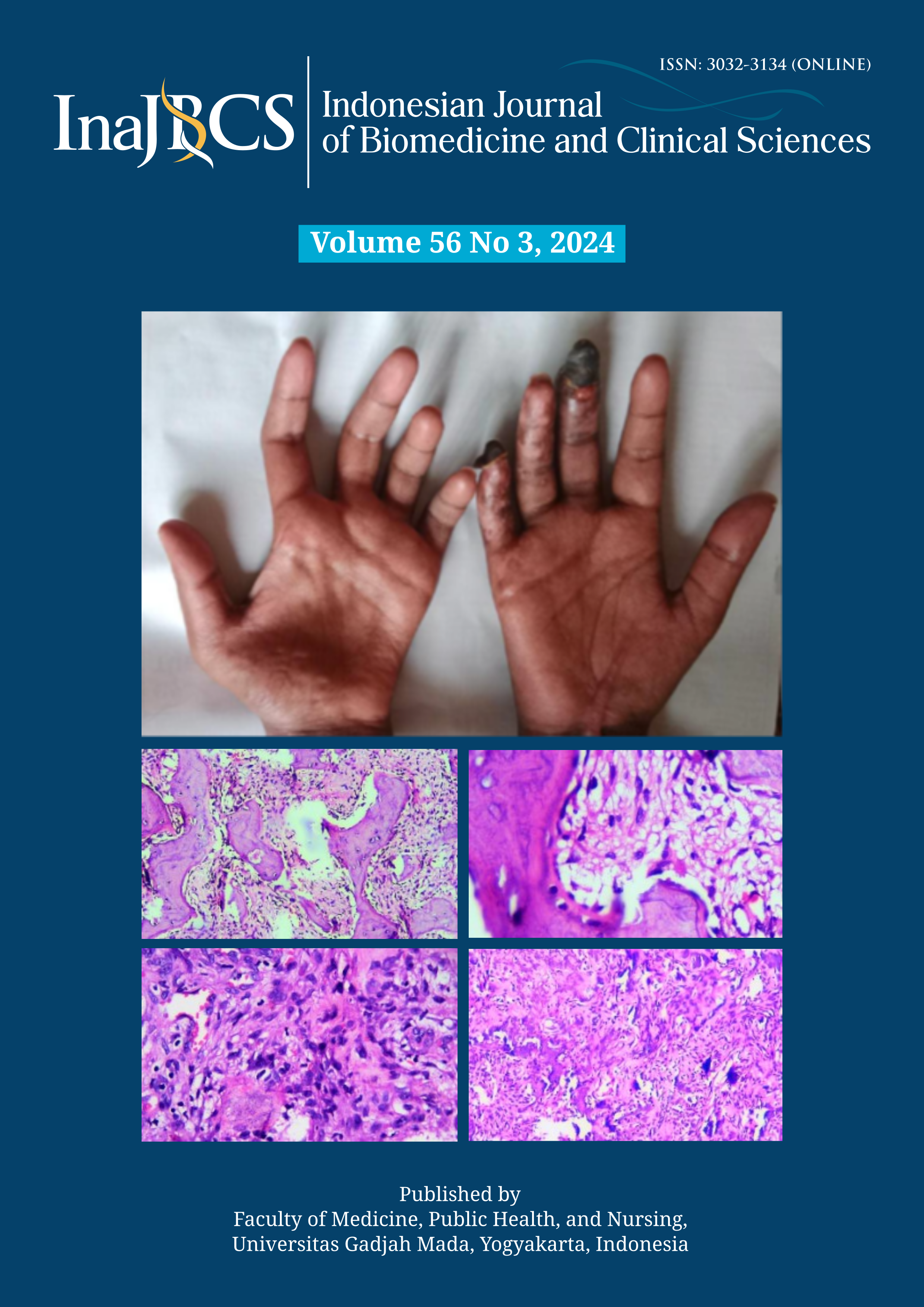C-reactive protein (CRP) and lactate dehydrogenase (LDH) as functional outcome predictors in stroke patients
Abstract
Stroke is a neurologic disorder with high mortality and disability. Its pathophysiology is associated with vascular inflammation. However, studies between vascular inflammatory markers and stroke outcomes are still limited. This study aimed to investigate the association between inflammatory markers and functional outcomes of stroke. This was a retrospective cohort study involving all stroke patients at the Dr. Sardjito General Hospital, Yogyakarta from October 2020 to August 2021 who meet the inclusion and exclusion criteria. Mann-Whitney was used for bivariate analysis, followed by multivariate analysis. A total of 269 subjects, with 213 infarcts (79.2%) and 56 hemorrhagic (20.8%) strokes. There were 83 subjects deceased (30.9%), with 66 infarct (31%) and 17 hemorrhagic (30.4%) strokes. High CRP levels had significant and independent associations with worse GCS, ADL, IADL, NIHSS, BI, SSGM, MRS, and higher mortality rates (p < 0.05). High LDH levels had a significant and independent association with worse GCS scores and higher mortality rates (p < 0.05). Sub-analysis showed high CRP and LDH had associations with high mortality rates in infarct (p < 0.001), but only CRP (p = 0.029) had associations with high mortality rates in hemorrhagic. There was no significant association between fibrinogen and procalcitonin with stroke outcomes (p > 0.05). Cox-regression analysis showed CRP>24.5 mg/dL and LDH >300U/L associated with hazard ratios of 3.2 (p < 0.001) and 1.65 (p = 0.026). In conclusion. high CRP and LDH levels are associated with mortality rates in stroke patients.
References
Ahmadi-Ahangar A. Predictive ability of C-reactive protein for stroke. Caspian J Intern Med 2016; 7(3):151-2.
Ministry of Health of Indonesia, Riskesdas Tahun 2018 (Basic Health Research 2018), https://pusdatin.kemkes.go.id/download.php?file=download/pusdatin/infodatin/infodatin-stroke-dont-be-the-one.pdf.
Bakhshayesh-Eghbali B, Roudbary SA, Basir Jafari S, Nabizadeh SP, Naderi-Asrami N, Sohrabnejad R. Ability of serum C-reactive protein and white blood cell count in predicting acute ischemic stroke. A short -term follow-up study. Caspian J Intern Med 2016; 7(3):206-10.
Shoaeb MA, Shehata MA, Taema KM, Hammouda MA. CRP in cerebrovascular stroke: Prognostic implications. Egyptian Crit Care Med 2014; 2(1):43-52.
https://doi.org/10.1016/j.ejccm.2014.03.001
Chauduri JR, Mridula KR, Umamahesh M, Swathi A, Balaraju B, Bandaru VC. High sensitivity C-reactive protein level in acute ischemic stroke and subtypes: A study from a tertiary care center. Iran J Neurol 2013; 12(3):92-7.
Serpero LD, Bellissima V, Colivicchi M, Sabatini M, Frigiola A, Ricotti A, et al. Next generation biomarkers for brain injury. J Matern Fetal Neonatal Med 2013; 26(sup2):44-9.
https://doi.org/10.3109/14767058.2013.829688
Wu LW, Kao TW, Lin CM, Yang HF, Sun YS, Liaw FY, et al. Examining the association between serum lactic dehydrogenase and all-cause mortality in patients with metabolic syndrome: a retrospective observational study. BMJ Open 2016; 6(5):e011186.
https://doi.org/10.1136/bmjopen-2016-011186
Yan D, Huang Q, Dai C, Ren W, Chen S. Lactic dehydrogenase to albumin ratio is associated with the risk of stroke-associated pneumonia in patients with acute ischemic stroke. Front Nutr 2021; 8:743216.
https://doi.org/10.3389/fnut.2021.743216
Wang A, Tian X, Zuo Y, Wang X, Xu Q, Meng X, et al. High lactate dehydrogenase was associated with adverse outcomes in patients with acute ischemic stroke or transient ischemic attack. Ann Palliat Med 2021; 10(10):10185-95.
https://doi.org/10.21037/apm-21-2195
Yan L, Wang S, Xu L, Zhang Z, Liao P. Procalcitonin as a prognostic marker of patients with acute ischemic stroke. J Clin Lab Anal 2020; 34(7):e23301.
https:/doi.org/10.1002/jcla.23301
Deng WJ, Shen RL, Li M, Teng JF. Relationship between procalcitonin serum levels and functional outcome in stroke patients. Cell Mol Neurobiol 2015; 35(3):355-61.
https://doi.org/10.1007/s10571-014-0131-0
Giannopoulos S, Kosmidou M, Hatzitolios AI, Savopoulos CG, Ziakas A, Karamouzis M. Measurements of endothelin-1, C-reactive protein and fibrinogen plasma levels in patients with acute ischemic stroke. Neurol Res 2008; 30(7):727-30.
https://doi.org/10.1179/174313208X297904
Prasetiyo YW, Husni A, Tugasworo D. Hubungan antara jumlah neutrofil dan kadar hs-CRP serum dengan luaran klinis penderita stroke iskemik. Neurona (Majalah Kedokteran Neuro Sains Perhimpunan Dokter Spesialis Saraf Indonesia). 2017; 34(3).
Adams RD, Victor M, Ropper AH, Samuels MA, Klein J. Principles of neurology: Chapter 16. Coma and Related Disorders of Consciousness Twelfth edition. New York: McGraw-Hill; 2023. p.361-86.
Liu Y, Wang J, Zhang L, Wang C, Wu J, Zhou Y, et al. Relationship between C-reactive protein and stroke: a large prospective community based study. PloS one 2014; 9(9):e107017.
https://doi.org/10.1371/journal.pone.0107017
Matsuo R, Ago T, Hata J, Wakisaka Y, Kuroda J, Kuwashiro T, et al. Plasma C-reactive protein and clinical outcomes after acute ischemic stroke: a prospective observational study. PLoS One 2016; 11(6):e0156790.
https://doi.org/10.1371/journal.pone.0156790
Wang A, Tian X, Zuo Y, Wang X, Xu Q, Meng X, et al. High lactate dehydrogenase was associated with adverse outcomes in patients with acute ischemic stroke or transient ischemic attack. Ann Palliat Med 2021; 10(10):10185-95.
https://doi.org/10.21037/apm-21-2195
Rocco A, Ringleb PA, Grittner U, Nolte CH, Schneider A, Nagel S. Follow-up C-reactive protein level is more strongly associated with outcome in stroke patients than admission levels. Neurol Sci 2015; 36(12):2235-41.
https://doi.org/10.1007/s10072-015-2342-7
Liu LB, Li M, Zhuo WY, Zhang YS, Xu AD. The role of hs-CRP, D-dimer, and fibrinogen in differentiating etiological subtypes of ischemic stroke. PLoS One 2015; 10(2):e0118301.
https://doi.org/10.1371/journal.pone.0118301
Di Napoli M, Papa F, Bocola V. Prognostic influence of increased C-reactive protein and fibrinogen levels in ischemic stroke. Stroke 2001; 32(1):133-8.
https://doi.org/10.1161/01.str.32.1.133
Miyakis S, Georgakopoulos P, Kiagia M, Papadopoulou O, Pefanis A, Gonis A, et al. Serial serum procalcitonin changes in the prognosis of acute stroke. Clin Chim Acta 2004; 350(1-2):237-9.






